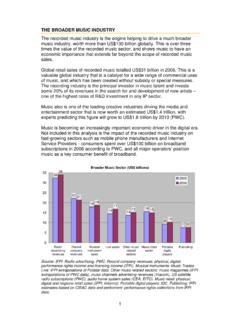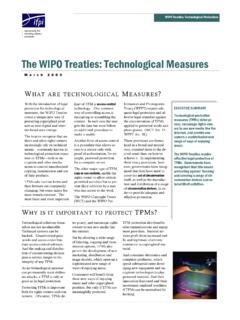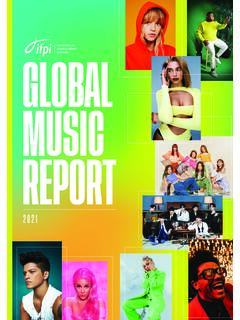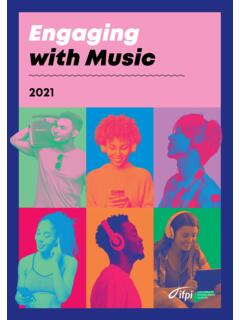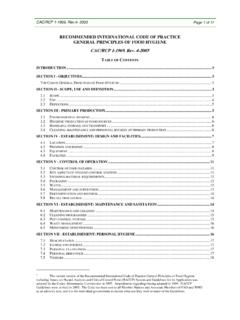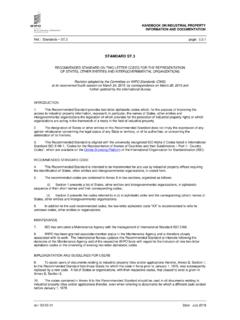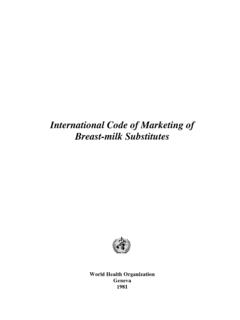Transcription of International Standard Recording Code (ISRC) …
1 International Standard Recording code (ISRC) Handbook3rd E dition, 2 009, Int ernational ISRC Agen cy ( IFPISe cretariat), LO NDON 2009 IFPI Se cretariatThis work is licensed under the Creative Commons Attribution-No Derivative Works UK: England&Wales License. To view a copy of this licence, send a letter to Creative Commons, 171 Second Street, Suite 300, San Francisco, California 94105, for other uses (includingtranslation) must be sought from the International ISRC Agency(IFPI Secretariat).To ensure that up-to-date information is used, a link to the ISRC website at ispreferred to copyingthis 3rdEdition is a minor revision of the 2003 (2nd) edition removing in particular the list of NationalAgencies which is now hosted on the ISRC website. The next edition will incorporate moresubstantive revisions and suggestions for issues that should be included are welcome and should besent Handbook3rdEditionAugust of ISO 3901 and purpose of the Benefits of of the ISRC of the of Reference between Sound and Music Video of the Audio Music Video and other analogue tape Distributed in Repertoire Handbook3rdEditionAugust by National by of the application of an Video Expired onto of in Particular Edits / Session in the playing (pot-pourris).
2 Of ISRC to existing of historical sold, licensed to /or distributed by Implementation in METADATA INTERCHANGE AGENCY APPOINTMENT AND for the Appointment of National for Reporting By National OF ONE: LIST OF TWO APPLICATION FOR APPOINTMENT OF NATIONAL ISRC Handbook3rdEditionAugust 20094 Background25 Part 1 Contact 2 Rationale for 3 Capacity to Fulfil the Handbook3rdEditionAugust 200952 BackgroundThis handbook is designed to provide guidance on the implementation of the International StandardRecording code (ISRC).ISRC was developed by the International Recording industry through the International Organisationfor Standardisation (ISO) as a response to a need to identify sound and music video recordings. Thecurrent version is known as International Standard ISO 3901 is a worldwide federation of national standards bodies.
3 ISO 3901:2001 was prepared and isadministered by Technical Committee ISO/TC 46, Information and documentation, Subcommittee 9,Presentation, identification and description of documents and was ratified as an internationalstandard in 2001, following the adoption of the original Standard in International Federation of the Phonographic Industry (IFPI) has recommended since 1988 to itsmembers that ISRC should be adopted as an International means of identification of soundrecordings and short form music 1989 IFPI Secretariat was appointed the International Registration Authority for ISRC by ISO andfunctions as the International ISRC Agency; and since 1989, 49 National Agencies have beenappointed by the International Handbookexplains how the system works and what has to be done to ensure that ISRC sare correctly assigned. It has been completely revised from the previous editions of the ISRCP ractical Guide, which are withdrawn.
4 It reflects the changes thathave been made in the revision toISO 3901 Handbookwill be reissued on an annual basis to reflect agreed practice in the use andadministration of of ISO 3901 and purpose of the ISRCThe International Standard Recording code (ISRC) provides a means of uniquely identifyingsoundrecordings and music videos internationally. For the purposes of this handbook, a musicvideorecording is defined as a short form music video initially produced to support the releaseof a is stressed that ISRC identifies sound recordings and music video recordings and notphysicalproducts ( carriers ) and that there is no conflict with existing product cataloguenumbering systemswith which it co-exists. Neither does ISRC identify a digitally distributedpackage, although sound andmusic video recordings included in such a package should beidentified with an ISRC system is constructed so that any entity creatingsound recordings can obtain themeans toissue ISRC sregardless of their membership, of or standing with, industryassociations and Handbook3rdEditionAugust PrinciplesEach distinct Recording is to have its own unique first owner or current owner of the rights to a Recording normally assigns the ISRC,providing noISRC has been issued before.
5 It identifies the Recording throughout its life and isintended for use byproducers of sound recordings and music videos ( record labels), aswell as by copyrightorganisations, broadcasting organisations, libraries, licensees new or materially changed Recording must be provided with a new ISRC (see Edits / ). Re-use of an ISRC that has already been allocated for anotherrecording is notpermitted see Section No arecording is sold or licensed and is then released unchanged the ISRC remains the Benefits of ISRCThe ISRC has been developed in order to facilitate the accurate exchange of information ontheownership, the use of recordings and to simplify the administration of rights in them. Itis a global,unique method of identifying sound and music video identifying all sound and music video recordings that are released, regardless of the formatthatthey are released in, the ISRC enablesthe tracking and tracing of these recordingsthrough the musicvalue users of sound and music video recordings will also find it easier to obtaininformationabout the current rights owner because repertoire databases will provide thisinformation with addition in many territories the ISRC is increasingly becoming a tool in the fight adoption of the ISRC system by the music community as a whole has the , being the worldwide recognisedstandard for Recording identification.
6 Can easily beaccepted and implemented internationally and allow interoperation of different databasesand ISRC coding system is compatible with standards developed in the field of in appropriate digital and manufactured Recording media it isreadable by hardware ISRC is increasingly used in electronic copyright management systems and DigitalRightsManagement implementation of ISRC is cost effective; ISRC can be put into operation withoutrequiring special investment in equipment. It only requires a structure able to deal withtheadministration of ISRC within the organisation using of the ISRC systemThe administration of the ISRC system is carried out at two levels:ISRC Handbook3rdEditionAugust AdministrationThe International administration of the ISRC system is in the hands of the InternationalISRC Agency(IFPI Secretariat).The address of the International Agency is: International ISRC AgencyIFPI Secretariat10 PiccadillyLondon W1J 0 DDUnited KingdomTelephone: +44 (0) 20 7878 7900 Fax: +44 (0) 20 7878 responsibilities of the International ISRC Agency promote the worldwide use of the system; appoint the National (or regional) ISRC Agencies and to maintain a list ofthe appointedNational ISRC Agencies; administer the ISRC system for territories where no National ISRC Agencyexists; recommend procedures for the efficient implementation of the ISRC systemand topublish these from time to time; answer queries on the implementation of the ISRC system.
7 Report annually to ISO on its activities, the worldwide adoption of ISRC, andthe continuedrelevance of the text of ISO 3901 and to recommend anychanges AdministrationThe administration of ISRC within territories is delegated to appointed agencies, whichform the linkbetween Registrants and the InternationalISRC list of appointed ISRC Agencies is contained in Appendix one: List of agencies and isalso availableon the International ISRC Agency website ( ). This is keptfully up to responsibilities of National Agencies are request, allocate Registrant Codes to all those in their territory wishing toregister soundrecordings and music video recordings, regardless of theapplicants membership of, orstanding with, the National Agency, industryassociations and otherbodies; all Registrants of the appropriate Country code ; the use of the ISRC system to Recording industry and other entitiesand use bestendeavours to ensure that an ISRC is allocated to all soundrecordings and music videorecordings issued in their territory; the proper allocation of ISRCs to sound recordings where noallocation was madeon release.
8 ISRC Handbook3rdEditionAugust a record of all Registrant Codes and to which entities they were allocatedand inaccordance with ISO 3901:2001, Annex maintain a listing:CountrycodeRegistrantcodeRegistr ant (Name,Address and othercontact details)Department or personto be contacted (ifnecessary)DateRegistrantCode annually to the International ISRCA gency on the Registrant Codesallocated in theirterritory (as above) and on implementation of ISRC; Registrants with guidelines in local languages where appropriate, onthe practicalimplementation of the system and resolve operational problems inliaison with theInternationalISRC Agency to prevent inconsistencies; as controller and arbitrator for all ISRC matters in its country, taking advicefrom theInternational ISRC Agency where appropriate; as far as possible that all sound recordings and music video recordingsreleased intheir territory are included in appropriate repertoire databaseswhether operated by theAgency itself or by another entity on a national orregional of the ISRCThe following description summarises the International Standard ISO 3901: 2001 but does notreplace it.
9 Where interpretation is required, reference should be made to the ISO document,whichis authoritative. Copies of ISO3901: 2001 can be obtained from national standardsbodies and directfrom ISO ( ). is a unique identifier for sound and music video recordings where one, and only one,identifyingcode is allocated to each version of the code allocation purposes, the ISRC is separated into its different elements. Howeverwhen thecode is being used, it is the whole number that represents the sound or musicvideo Recording andno significance should be accorded to any one element. In particular,the Registrant code (seeSection Registrant code ) cannot be assumed to identifyacurrent rights owner as therecording may have changed hands since code rights may vary territory byterritory. Further, the year of reference cannot beassumed to be a year of Recording . It representsthe year the ISRC was assigned, whichmay or may not be the year the sound Recording was released(see Section Year ofReference).
10 The ISRC is alphanumeric, using digits (the ten Arabic numerals 0-9) and the 26 lettersof the Romanalphabet. The ISRC consists of twelve characters representing country (2characters), Registrant (3characters), Year of Reference (2 digits) and Designation (5digits). For visual presentation it isdivided into four elements separated by hyphens andthe letters ISRC should always precede an ISRC code . The hyphens are however not partof the ISRC. See Section ISRC Implementation inSoftware for presentation of ISRCin computer software. The elements appear in the following order:-Country code -Registrant code -Year of ReferenceISRC Handbook3rdEditionAugust 20099-Designation CodeThe structure of the ISRC is shown in the following example:ISRC FR-Z03-98 00212 ISRCFRZ039800212 code identifierCountry code (2 characters)FR = FranceRegistrant code (3 characters)Z03=MercuryFranceYear of Reference(2 digits)98 =1998 DesignationCode(5 digits) CodeThe Country code identifies the country of residence of the registrant.



